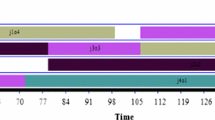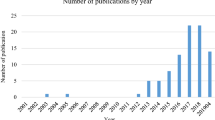Abstract
A reconfigurable manufacturing system (RMS) is one of the next generation production systems widely used to meet uncertain market demands in the context of Industry 4.0. The design of the RMS aims to achieve sufficient responsiveness so that it can be quickly adopted to the changes required for a niche market of a customized product family. Most components of the RMS are designed to be modular. Reconfigurable machines are one of the main modular components of the RMS. In the design of the RMS, the problem of machine selection is of primary interest, as the modular machines, with their respective tools and configurations, are selected to perform a given part from the part family. Due to this trilogy of machine, tool, and configuration selection, only one type of machine is considered. To remedy this shortcoming, this work introduces a new concept of modular machine configuration capability, which leads to the selection of two types of machines, namely, the single-spindle modular reconfigurable machines (SRMT) and the multi-spindle reconfigurable machines (MRMT). This paper addresses the problem of machine selection and RMS design. Firstly, a bi-objective mathematical model is developed for the generation of the process plan and the selection of reconfigurable machines. The results obtained, together with an initial layout, are then used to generate the RMS design. Secondly, a new objective function is introduced to address the problem of under-utilization of reconfigurable multi-spindle machines. A NSGA-III (non-dominating sorting genetic algorithm III)-based approach is proposed to solve the proposed models. To help the decision maker, the pseudo-weight technique is used to determine the best process plan and the best machines to include in the new designed RMS.

















Similar content being viewed by others
Data availibility
All the data have been presented in the manuscript.
Abbreviations
- NGMS:
-
Next generation manufacturing systems
- OAC:
-
Open architecture control
- RTOS:
-
Real-time operating systems
- TADs:
-
Tool approach directions
- RMS:
-
Reconfigurable manufacturing system
- RMT:
-
Reconfigurable machine tools
- RAM:
-
Reconfigurable assembly machine
- RIM:
-
Reconfigurable inspection machine
- MRM:
-
Modular reconfigurable machine
- SRMT:
-
Single-spindle modular reconfigurable machines
- MRMT:
-
Multi-spindle reconfigurable machines
- NSGA-III:
-
Non-dominating sorting genetic algorithm III
References
Ameer M, Dahane M (2020) New heuristic for setup plan generation and multi tool modules selection in reconfigurable manufacturing systems. In: 2020 7th International Conference on Control, Decision and Information Technologies (CoDIT), vol 1, pp 1069–1074. IEEE
Ameer M, Dahane M (2021) Reconfigurability improvement in industry 4.0: a hybrid genetic algorithm-based heuristic approach for a co-generation of setup and process plans in a reconfigurable environment. J Intell Manufac 1–23
Ameer M, Dahane M (2023) A novel reconfigurability effort index for process planning generation in reconfigurable manufacturing system: NSGA-III multi-objective based approach. Submitted Comput Ind Eng J
Arnarson H, Yu H, Olavsbråten MM, Bremdal BA, Solvang B (2023) Towards smart layout design for a reconfigurable manufacturing system. J Manufac Syst 68:354–367
Asghar E, Baqai AA, Zaman U (2015) Performance of NSGA-II and WGA in macro level process planning considering reconfigurable manufacturing system. In: Proceedings of 25th International Conference on Flexible Automation and Intelligent Manufacturing, vol 2. pp 320–327
Azab A, ElMaraghy H (2007) Mathematical modeling for reconfigurable process planning. Cirp Annals 56(1):467–472
Bechikh S, Datta R, Gupta A (2016) Recent advances in evolutionary multi-objective optimization, vol 20. Springer
Benderbal HH, Dahane M, Benyoucef L (2018) Modularity assessment in reconfigurable manufacturing system (RMS) design: an archived multi-objective simulated annealing-based approach. Int J Adv Manufac Technol 94(1–4):729–749
Bensmaine A, Dahane M, Benyoucef L (2013) A non-dominated sorting genetic algorithm based approach for optimal machines selection in reconfigurable manufacturing environment. Comput Ind Eng 66(3):519–524
Bensmaine A, Dahane M, Benyoucef L (2014) A new heuristic for integrated process planning and scheduling in reconfigurable manufacturing systems. Int J Prod Res 52(12):3583–3594
Blank J, Deb K (2020) Pymoo: multi-objective optimization in python. IEEE Access 8:89497–89509
Bortolini M, Galizia FG, Mora C (2018) Reconfigurable manufacturing systems: literature review and research trend. J Manufac Syst 49:93–106
Cheung BC, Carriveau R, Ting DS (2014) Multi-objective optimization of an underwater compressed air energy storage system using genetic algorithm. Energy 74:396–404
Deb K (2011) Multi-objective optimisation using evolutionary algorithms: an introduction. In: Multi-objective evolutionary optimisation for product design and manufacturing. Springer, pp 3–34
Deb K, Jain H (2013) An evolutionary many-objective optimization algorithm using reference-point-based nondominated sorting approach, part i: solving problems with box constraints. IEEE Trans Evol Comput 18(4):577–601
Dhupia J, Powalka B, Katz R, Ulsoy AG (2007) Dynamics of the arch-type reconfigurable machine tool. Int J Mach Tools Manufac 47(2):326–334
Gadalla M, Xue D (2017) Recent advances in research on reconfigurable machine tools: a literature review. Int J Prod Res 55(5):1440–1454
Haddou-Benderbal H, Dahane M, Benyoucef L (2016) Hybrid heuristic to minimize machine’s unavailability impact on reconfigurable manufacturing system using reconfigurable process plan. IFAC-PapersOnLine 49(12):1626–1631
Haddou Benderbal H, Dahane M, Benyoucef L (2017) Flexibility-based multi-objective approach for machines selection in reconfigurable manufacturing system (RMS) design under unavailability constraints. Int J Prod Res 55(20):6033–6051
Ismail N, Musharavati F, Hamouda A, Ramli A (2008) Manufacturing process planning optimisation in reconfigurable multiple parts flow lines. J Achiev Mater Manuf Eng 31(2):671–677
Jain H, Deb K (2013) An evolutionary many-objective optimization algorithm using reference-point based nondominated sorting approach, part ii: handling constraints and extending to an adaptive approach. IEEE Trans Evol Comput 18(4):602–622
Kannan M, Saha J (2009) A feature-based generic setup planning for configuration synthesis of reconfigurable machine tools. Int J Adv Manuf Technol 43(9–10):994–1009
Koren Y (2013) The rapid responsiveness of RMS. Int J Prod Res 51(23–24):6817–6827
Li X, An Q, Zhang J, Mao X, Tang R, Xu F, Dong Z, Feng Y, Li X (2021) A novel optimization framework for integrated local energy system multi-objective dispatch problem based on dynamic knowledge base. Int J Electr Power Energy Syst 128(106):736
Maniraj M, Pakkirisamy V, Parthiban P (2014) Optimisation of process plans in reconfigurable manufacturing systems using ant colony technique. Int J Enterp Netw Manag 6(2):125–138
Moghaddam SK, Houshmand M, Saitou K, Fatahi Valilai O (2020) Configuration design of scalable reconfigurable manufacturing systems for part family. Int J Prod Res 58(10):2974–2996
Padayachee J, Bright G, Masekamela I (2009) Modular reconfigurable machine tools: design, control and evaluation. South African J Ind Eng 20(2):127–143
Pansare R, Yadav G, Nagare MR (2023) A hybrid framework to prioritize the performance metrics of reconfigurable manufacturing system (RMS) using fuzzy AHP-TOPSIS method. Int J Adv Manuf Technol 124(3–4):863–885
Ribau JP, Sousa JM, Silva CM (2015) Reducing the carbon footprint of urban bus fleets using multi-objective optimization. Energy 93:1089–1104
Singh A, Asjad M, Gupta P (2019) Reconfigurable machine tools: a perspective. Life Cycle Reliab. Saf. Eng 8(4):365–376
Son H, Choi HJ, Park HW (2010) Design and dynamic analysis of an arch-type desktop reconfigurable machine. Int J Mach Tools Manuf 50(6):575–584
Spicer P, Koren Y, Shpitalni M, Yip-Hoi D (2002) Design principles for machining system configurations. CIRP Annals 51(1):275–280
Wang G, Shang X, Yan Y, Allen JK, Mistree F (2018) A tree-based decision method for the configuration design of reconfigurable machine tools. J Manuf Syst 49:143–162
Wang Y, Zhang G, Han L (2019) A methodology of setting module groups for the design of reconfigurable machine tools. Int J Adv Manuf Technol 104(5–8):2133–2147
Weston R, Cui Z (2008) Next generation manufacturing systems. In: Global Design to Gain a Competitive Edge. Springer, pp 701–710
Yelles-Chaouche AR, Gurevsky E, Brahimi N, Dolgui A (2020) Reconfigurable manufacturing systems from an optimisation perspective: a focused review of literature. Int J Prod Res 1–19
Zhang Z, Xu F, Sun X (2022) Optimization of process parameters during hydroforming of tank bottom using NSGA-III algorithm. Int J Adv Manuf Technol 119(5–6):4043–4055
Author information
Authors and Affiliations
Contributions
Muhammad Ameer: formal analysis, original draft writing, and validation.
Mohammed Dahane: conceptualization, methodology, writing—review and editing, programming, and validation.
Corresponding author
Ethics declarations
Ethical approval
Not applicable.
Consent to participate
Not applicable. The article involves no studies on humans.
Consent for publication
All authors have read and agreed to the published version of the manuscript.
Conflict of interest
The authors declare no competing interests.
Additional information
Publisher's Note
Springer Nature remains neutral with regard to jurisdictional claims in published maps and institutional affiliations.
Appendix
Appendix
Rights and permissions
Springer Nature or its licensor (e.g. a society or other partner) holds exclusive rights to this article under a publishing agreement with the author(s) or other rightsholder(s); author self-archiving of the accepted manuscript version of this article is solely governed by the terms of such publishing agreement and applicable law.
About this article
Cite this article
Ameer, M., Dahane, M. NSGA-III-based multi-objective approach for reconfigurable manufacturing system design considering single-spindle and multi-spindle modular reconfigurable machines. Int J Adv Manuf Technol 128, 2499–2524 (2023). https://doi.org/10.1007/s00170-023-11847-7
Received:
Accepted:
Published:
Issue Date:
DOI: https://doi.org/10.1007/s00170-023-11847-7




